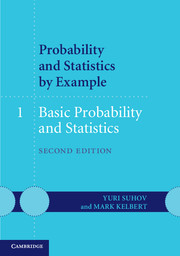Refine search
Actions for selected content:
2348 results in Statistical theory and methods
10 - Mechanisms and Causal Explanation
-
- Book:
- Counterfactuals and Causal Inference
- Published online:
- 05 December 2014
- Print publication:
- 17 November 2014, pp 325-353
-
- Chapter
- Export citation
12 - Distributional Assumptions, Set Identification, and Sensitivity Analysis
-
- Book:
- Counterfactuals and Causal Inference
- Published online:
- 05 December 2014
- Print publication:
- 17 November 2014, pp 419-434
-
- Chapter
- Export citation
8 - Self-Selection, Heterogeneity, and Causal Graphs
-
- Book:
- Counterfactuals and Causal Inference
- Published online:
- 05 December 2014
- Print publication:
- 17 November 2014, pp 267-290
-
- Chapter
- Export citation
I - Causality and Empirical Research in the Social Sciences
-
- Book:
- Counterfactuals and Causal Inference
- Published online:
- 05 December 2014
- Print publication:
- 17 November 2014, pp 1-2
-
- Chapter
-
- You have access
- Export citation
11 - Repeated Observations and the Estimation of Causal Effects
-
- Book:
- Counterfactuals and Causal Inference
- Published online:
- 05 December 2014
- Print publication:
- 17 November 2014, pp 354-416
-
- Chapter
- Export citation
5 - Matching Estimators of Causal Effects
-
- Book:
- Counterfactuals and Causal Inference
- Published online:
- 05 December 2014
- Print publication:
- 17 November 2014, pp 140-187
-
- Chapter
- Export citation

Probability and Statistics by Example
-
- Published online:
- 05 October 2014
- Print publication:
- 22 September 2014
Frontmatter
-
- Book:
- Probability and Statistics by Example
- Published online:
- 05 October 2014
- Print publication:
- 22 September 2014, pp i-iv
-
- Chapter
- Export citation
Contents
-
- Book:
- Probability and Statistics by Example
- Published online:
- 05 October 2014
- Print publication:
- 22 September 2014, pp v-vi
-
- Chapter
- Export citation
1 - Discrete outcomes
-
- Book:
- Probability and Statistics by Example
- Published online:
- 05 October 2014
- Print publication:
- 22 September 2014, pp 3-135
-
- Chapter
- Export citation
2 - Continuous outcomes
-
- Book:
- Probability and Statistics by Example
- Published online:
- 05 October 2014
- Print publication:
- 22 September 2014, pp 136-246
-
- Chapter
- Export citation
PART TWO - BASIC STATISTICS
-
- Book:
- Probability and Statistics by Example
- Published online:
- 05 October 2014
- Print publication:
- 22 September 2014, pp 247-248
-
- Chapter
- Export citation
5 - Cambridge University Mathematical Tripos examination questions in IB Statistics
-
- Book:
- Probability and Statistics by Example
- Published online:
- 05 October 2014
- Print publication:
- 22 September 2014, pp 369-447
-
- Chapter
- Export citation
Index
-
- Book:
- Probability and Statistics by Example
- Published online:
- 05 October 2014
- Print publication:
- 22 September 2014, pp 458-461
-
- Chapter
- Export citation
Preface
-
- Book:
- Probability and Statistics by Example
- Published online:
- 05 October 2014
- Print publication:
- 22 September 2014, pp vii-xiv
-
- Chapter
- Export citation
4 - Hypothesis testing
-
- Book:
- Probability and Statistics by Example
- Published online:
- 05 October 2014
- Print publication:
- 22 September 2014, pp 304-368
-
- Chapter
- Export citation
Appendix - Tables of random variables and probability distributions
-
- Book:
- Probability and Statistics by Example
- Published online:
- 05 October 2014
- Print publication:
- 22 September 2014, pp 448-449
-
- Chapter
- Export citation
PART ONE - BASIC PROBABILITY
-
- Book:
- Probability and Statistics by Example
- Published online:
- 05 October 2014
- Print publication:
- 22 September 2014, pp 1-2
-
- Chapter
- Export citation
Bibliography
-
- Book:
- Probability and Statistics by Example
- Published online:
- 05 October 2014
- Print publication:
- 22 September 2014, pp 450-457
-
- Chapter
- Export citation
3 - Parameter estimation
-
- Book:
- Probability and Statistics by Example
- Published online:
- 05 October 2014
- Print publication:
- 22 September 2014, pp 249-303
-
- Chapter
- Export citation
